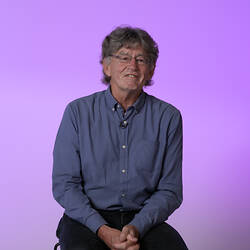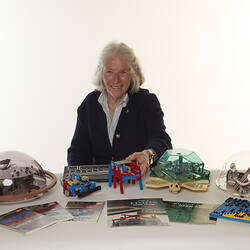David Williams is an Australian mathematics and science teacher, teacher educator and educational consultant from the 1970s until the 2000s, who played an important role in the development of educational computing in Victoria and Australia.
Williams was directly engaged in exploring new approaches to teaching and learning that made use of computers and robotics as a teacher within the Sunrise School research program operated by the Australian Council of Educational Research in the late 1980s. Drawing on this experience, he helped spread computing and robotics to state and private schools as an educational consultant, while continuing to directly bring these new technologies to young people in his role as a teacher and through the facilitation of school and public workshops.
Williams completed a Bachelor of Science (Hons) degree at the University of Melbourne in 1966, followed by a Graduate Diploma of Education from the same university in 1968. He continued to pursue his interest in both science and education at the University of Melbourne, later completing a Master of Science (Physical Polymer Chemistry) and a Bachelor of Education.
In 1969, he was appointed lecturer in Chemistry at the Secondary Teachers' College and taught in the Bachelor of Science Education, a course being run in collaboration with the University of Melbourne to address the shortage of science teachers in Victoria. In 1972, he was seconded, through Australian Volunteers Abroad, to the Maktab Perguruan Temenggong Ibrahim teacher training college in Malaysia. He returned to teacher education in Australia in 1973, joining the State College of Victoria (into which his former organisation, the Secondary Teachers' College, had amalgamated).
In 1975, Williams moved into classroom teaching as a mathematics and science teacher at Braybrook High School. In 1976, he joined Princes Hill Secondary College in Carlton where he remained a senior mathematics and science teacher and supervisor of trainee teachers until 2000. During this time, he became actively involved in several professional associations, including the Computer Education Group of Victoria (CEGV), Science Teachers Association of Victoria (STAV), and Mathematics Association of Victoria (MAV).
In 1988, Princes Hill Secondary College accepted an invitation from the Australian Council of Educational Research to participate in the Sunrise School - a 'school of the future' research program it was developing to explore how computers (then a relatively new feature in schools) might be best used to enhance learning. In 1989, Williams became one of three Princes Hill Secondary College teachers engaged in the program. The Sunrise School itself was a dedicated space within the Museum of Victoria that housed a set of Apple IIE microcomputers running Logo (the world's first programming language designed for learning), Lego Technic robotics equipment that could be controlled using Logo, along with other digital technologies. Select Princes Hill Secondary College classes were bussed to the Sunrise School two afternoons each week where Williams and his colleagues engaged them in learning activities using this equipment and, sometimes, the cultural materials of the museum.
Through the Sunrise School experience, Williams became an expert in Logo and LEGO Technic robotics and teaching approaches informed by the constructivist and constructionist learning theories that were central to the research program. Although the Sunrise School at the Museum closed at the end of 1989, terminating Princes Hill Secondary College's official connection with the project, Williams remained involved as a consultant. He worked with Sunrise Program Director, Liddy Nevile, as Sunrise ventures were established at Methodist Ladies College (where it would be the kernel from which that school would become the world's first 'Laptop School'), Coombabah Primary School, Batlow Technology School and RMIT University. At the RMIT Sunrise Research Laboratory, Williams worked on a project introducing secondary students to Boxer, a computer software environment created at MIT as an extension of the Logo programming language. He also helped introduce ubiquitous personal computing and notebook computers to RMIT teaching staff in the early 1990s.
Williams' impact on the diffusion of computing and robotics to Australian schools extended beyond Sunrise. In 1992, he wrote the 'LEGO Technic II TC logo software Teacher Manual' that was published by the LEGO Company and widely used in Australian schools. During the 1990s, he helped many government schools introduce robotics and mathematical computational environments into their curriculum. He continued teaching robotics at Princes Hill Secondary College and facilitating school and public robotics workshops until his retirement in 2000. Between 2001 and 2007 he was a sessional lecturer in primary science education at Deakin University.
More Information
-
Keywords
-
Authors
-
Article types






